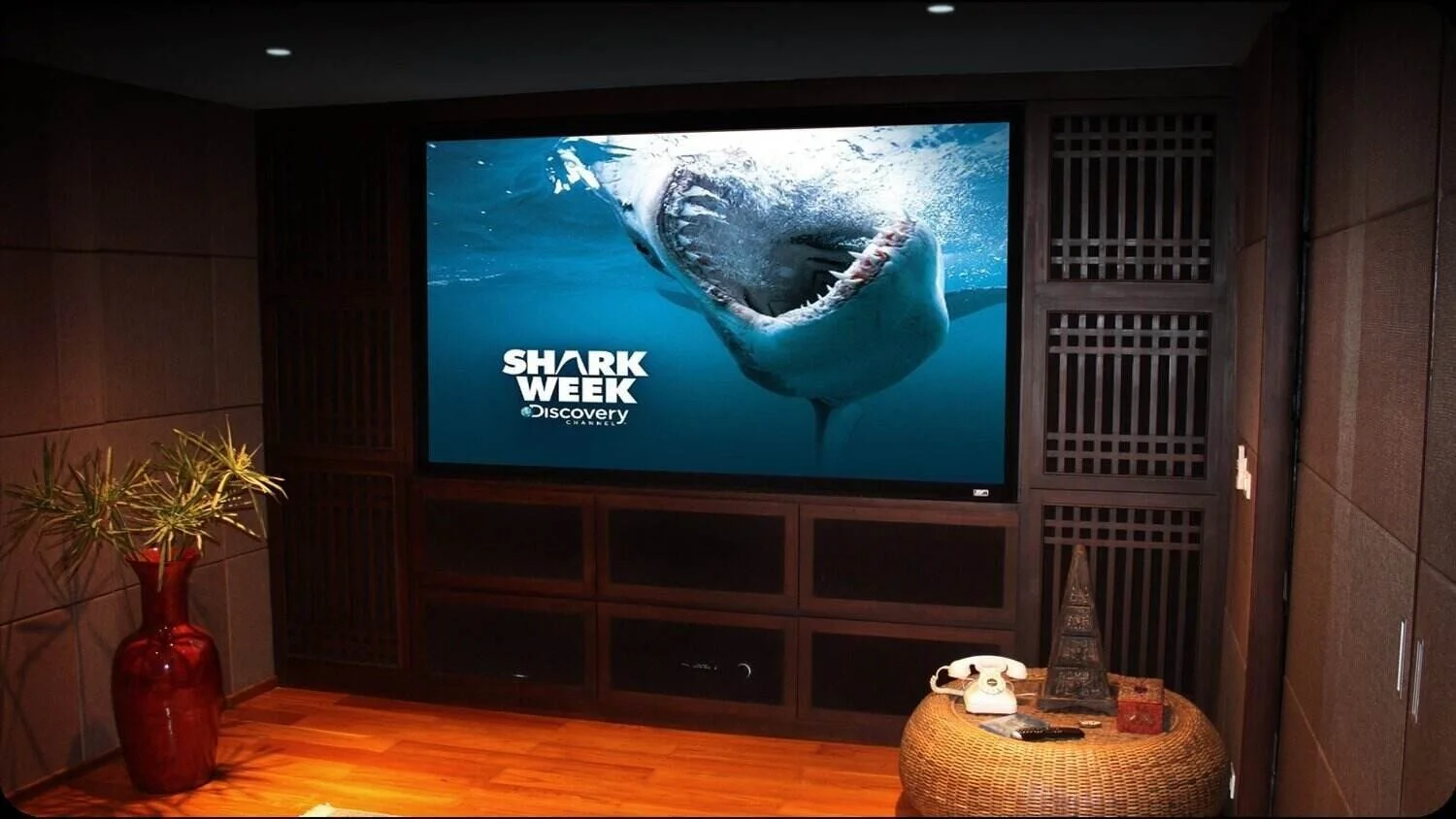
Projector vs TV — Which Is Best for Your Home Cinema Room?
How to choose the right display for your dream home cinema room. When planning a home cinema room, one of the first questions we’re asked is simple — “Should I use a projector or a TV?”
Introduction
It’s a great question, and the right answer depends on your lifestyle, room, budget, and the design of your home cinema, how you will be using your system and enjoying your room.
Both technologies have come a long way in recent years. Projectors now deliver outstanding brightness and 4K HDR performance, while televisions have become enormous, razor-sharp, and energy efficient.
Let’s look at the pros and cons of each so you can make an informed choice for your cinema room.
Projectors – The True Cinema Experience
Nothing beats the feeling of sitting in a comfy reclining seat watching a huge projected image fill the front of your room. Watching a movie on a projector creates that big-screen magic — the same awesome sense of scale you get in a real cinema.
Advantages of a projector system:
✅Cinematic scale: Screens can range from 100" to 160" and beyond, perfectly suited to 2.35:1 or 16:9 content.
✅Immersive feel: The picture size dominates your field of view, pulling you into the film.
✅Flexible installation: A projector can be ceiling-mounted, hidden in cabinetry, or even use a short-throw model in smaller rooms.
✅True widescreen formats: With a scope screen (2.35:1), movies display at full width without black bars.
✅Better value for large images: You’ll typically get far more screen area per pound than an equivalent-sized TV.
Considerations:
✅Light control: A projector looks best in a darkened room. Ambient light quickly reduces contrast.
✅Maintenance: Lamps (on older models) need replacing, and filters occasionally require cleaning.
✅Acoustic planning: The projector’s position and any potential fan noise need to be considered in your acoustic design.
✅Setup and calibration: Correct alignment and screen choice are vital to performance.
At Cinema@Home, we almost always recommend a projector for dedicated cinema rooms — especially when combined with acoustic wall panels, smart home lighting, and a huge 16:9 or 2.35:1 acoustically transparent screen.
Televisions – Bright, Simple, and Stunning
Modern OLED and especially the new Mini-LED televisions are brighter than ever, with superb black levels and HDR performance that’s hard to fault. For media rooms or living spaces such as lounges that double as cinemas or media rooms, a large TV can make a lot of sense.
Advantages of a large TV:
✅Excellent brightness and contrast: Perfect for rooms with windows or some ambient light.
✅Simplicity: Just switch on and watch — no calibration, no warm-up, no lens alignment.
✅Smart features: Built-in apps for Netflix, Disney+, and Apple TV make everyday use simple.
✅Low maintenance: No lamps or filters, instant startup.
✅Incredible picture quality: OLED and QLED models offer vivid colour and excellent HDR tone mapping.
Considerations:
✅Screen size limit: Even at 85" or 98", a TV doesn’t provide the same cinematic scale as a projector.
✅Reflections: Glossy screens can reflect light from windows or downlights.
✅Cost at large sizes: Ultra-large TVs (100"+) can be more expensive than a full projector system.
✅Aspect ratio: Movies filmed in 2.35:1 will still show black bars top and bottom.
For multi-purpose spaces or where daytime viewing is common, a high-quality TV can be the right choice. We often design hybrid systems that combine a large OLED with surround sound and smart lighting for flexible use.
Our Recommendation
If you’re building a dedicated home cinema, go for a 4K laser projector and an acoustically transparent screen. You’ll achieve the same immersive scale as a commercial cinema and create a true “lights-down” experience.
If you’re creating a multi-purpose family room or media lounge, a large OLED or Mini-LED TV can be ideal — bright, simple, and easy for everyone to use.
For many clients, we design hybrid systems — combining a drop-down projection screen with a large TV behind, giving the best of both worlds.
🎬 Projector vs TV — Quick Comparison
Compare the strengths and weaknesses of each for your custom home cinema room.
| Feature | Projector | TV |
|---|---|---|
| Screen Size | 100″–160″+ (true cinema scale) | 65″–98″ typical; 100″+ available at a premium |
| Best Environment | Dedicated dark cinema room | Living or media room with some light |
| Brightness | Lower; needs good light control or ALR screen | Very bright; perfect for daytime viewing |
| Contrast & HDR | Excellent on premium 4K laser models | Outstanding on OLED or Mini-LED |
| Setup Complexity | Requires calibration & alignment (lens, throw, screen) | Simple plug-and-play setup |
| Maintenance | Minimal with laser models; lamp/filter on older units | Virtually maintenance-free |
| Cost per Inch | Much better value for large screens | Cost rises sharply over 85″ |
| 2.35:1 (Scope) Support | Native with scope screens — full-width cinema | Letterboxed with black bars |
| Typical Use | Dedicated home cinemas — lights down, movie night | Hybrid rooms — TV, sport, gaming, casual viewing |
Our tip: For a dedicated cinema, choose a 4K laser projector with an acoustically transparent scope screen for the ultimate immersive experience.
For a multi-purpose space, a large OLED or Mini-LED TV offers unbeatable brightness and everyday simplicity.
FAQs
Q: Can a projector work in a room with windows?
Yes, with the right light control — blackout blinds or motorised curtains make a big difference. Alternatively, use an ambient light rejecting (ALR) screen.
Q: How long do projector lamps last?
Modern laser projectors often last 20,000 hours or more, effectively maintenance-free for years.
Q: Do TVs support 2.35:1 movies properly?
They display them with black bars, but image quality remains excellent. To fill a full-width scope screen, a projector is still best.
Q: Which gives better sound?
Both rely on external speakers. We recommend using in-wall or on-wall surround speakers for a proper cinematic effect regardless of display type.
Conclusion
Both technologies can deliver stunning results when designed properly. The key is choosing the right display for your room, lighting, and usage style.
At Cinema@Home, we’ll help you compare both options, demonstrate them side-by-side in our Market Harborough demo rooms, and design a system tailored to your lifestyle, space, and budget. Read about Projector vs TV for home cinema in Phuket.




